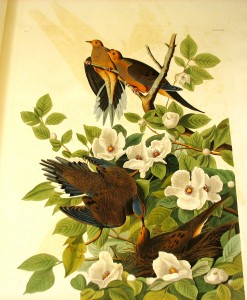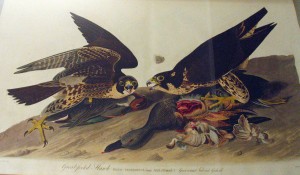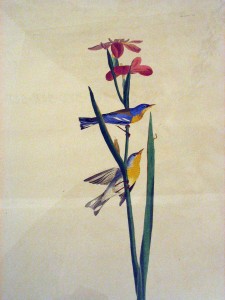 “The bird represented under the name of Bewick’s Wren I shot on the 19th October 1821, about five miles from St. Francisville, in the State of Louisiana. It was standing as nearly as can be represented in the position in which you now see it, and upon the prostrate trunk of a tree not far from a fence. My drawing of it was made on the spot. Another individual was shot a few days after, by a young friend, Joseph R. Mason [see below], who accompanied me on my rambles. In the month of November 1829, I had the pleasure of meeting with another of the same species, about fifteen miles from the place above mentioned . . . it moved along the bars of the fences, with its tail generally erect, looking from the bar on which it stood towards the one next above, and caught spiders and other insects, as it ran along from one panel of the fence to another in quick succession, now and then uttering a low twitter, the only sound which I heard it emit. It occasionally hopped sideways, now with its head towards me, and again in the contrary direction . . . [etc.]
“The bird represented under the name of Bewick’s Wren I shot on the 19th October 1821, about five miles from St. Francisville, in the State of Louisiana. It was standing as nearly as can be represented in the position in which you now see it, and upon the prostrate trunk of a tree not far from a fence. My drawing of it was made on the spot. Another individual was shot a few days after, by a young friend, Joseph R. Mason [see below], who accompanied me on my rambles. In the month of November 1829, I had the pleasure of meeting with another of the same species, about fifteen miles from the place above mentioned . . . it moved along the bars of the fences, with its tail generally erect, looking from the bar on which it stood towards the one next above, and caught spiders and other insects, as it ran along from one panel of the fence to another in quick succession, now and then uttering a low twitter, the only sound which I heard it emit. It occasionally hopped sideways, now with its head towards me, and again in the contrary direction . . . [etc.]
…I have honoured this species with the name of Bewick, a person too well known for his admirable talents as an engraver on wood, and for his beautiful work on the Birds of Great Britain, to need any eulogy of mine.”
CURATOR’S NOTE:
Accompanied by a thirteen year old student of his, Joseph Mason, Audubon sailed on a flatboat from Cincinnati on October 12, 1820. Mason would grow to be one of Audubon’s most important associates in the making of the Birds of America. Of the four hundred and thirty-five paintings, Joseph Mason painted the floral backgrounds in over fifty
Comments Off on Audubon “bird of the week”: Bewick’s Wren
 “I have tried, kind reader, to give you a faithful representation of two as gentle pairs of Turtles as ever cooed their loves in the green woods. I have placed them on a branch of Stuartia, which you see ornamented with a profusion of white blossoms, emblematic of purity and chastity.
“I have tried, kind reader, to give you a faithful representation of two as gentle pairs of Turtles as ever cooed their loves in the green woods. I have placed them on a branch of Stuartia, which you see ornamented with a profusion of white blossoms, emblematic of purity and chastity.
Look at the female, as she assiduously sits on her eggs, embosomed among the thick foliage, receiving food from the bill of her mate, and listening with delight
to his assurances of devoted affection. Nothing is wanting to render the moment as happy as could be desired by any couple on a similar occasion.
On the branch above, a love scene is just commencing. The female, still coy and undetermined, seems doubtful of the truth of her lover, and virgin-like resolves to put his sincerity to the test, by delaying the gratification of his wishes. She has reached the extremity of the branch, her wings and tail are already opening, and she will fly off to some more sequestered spot, where, if her lover should follow her with the same assiduous devotion, they will doubtless become as blessed as the pair beneath them.”
Comments Off on Audubon “bird of the week”: The Carolina Turtle Dove
 “Look at these two pirates eating their dejeuné à la fourchette, as it were, congratulating each other on the savouriness of the food in their grasp. One might think them real epicures, but they are in fact true gluttons. The male has obtained possession of a Green-winged Teal, while his mate has procured a Gadwal Duck. Their appetites are equal to their reckless daring, and they well deserve the names of “Pirates,” which I have above bestowed upon them.
“Look at these two pirates eating their dejeuné à la fourchette, as it were, congratulating each other on the savouriness of the food in their grasp. One might think them real epicures, but they are in fact true gluttons. The male has obtained possession of a Green-winged Teal, while his mate has procured a Gadwal Duck. Their appetites are equal to their reckless daring, and they well deserve the names of “Pirates,” which I have above bestowed upon them.
The Great-footed Hawk, or Peregrine Falcon, is now frequently to be met with in the United States, but within my remembrance it was a very scarce species in America. I can well recollect the time when, if I shot one or two individuals of the species in the course of a whole winter, I thought myself a fortunate mortal; whereas of late years I have shot two in one day, and perhaps a dozen in the course of a winter. It is quite impossible for me to account for this increase in their number, the more so that our plantations have equally increased, and we have now three gunners for every one that existed twenty years ago, and all of them ready to destroy a hawk of any kind whenever an occasion presents itself.”
Comments Off on Audubon “bird of the week,” The Great-footed Hawk
 [Male and female]. “This pretty species enters Louisiana from the south as early as spring appears, at the period when most insects are found closer to the ground, and more about water-courses, than shortly after, when a warmer sun has has invited every leaf and blossom to hail the approach of that season when they all become as brilliant as nature intended them to be. The little fellow under your eye is then seen flitting over damp places, such as the edges of ponds, lakes, and rivers, chasing its prey with as much activity and liveliness as any other of the delicate and interesting tribe to which it belongs. It alights on every plant in its way, runs up and down it, picks here and there a small winged insect, and should one, aware of its approach, fly off, pursues it and snatches it in an instant.
[Male and female]. “This pretty species enters Louisiana from the south as early as spring appears, at the period when most insects are found closer to the ground, and more about water-courses, than shortly after, when a warmer sun has has invited every leaf and blossom to hail the approach of that season when they all become as brilliant as nature intended them to be. The little fellow under your eye is then seen flitting over damp places, such as the edges of ponds, lakes, and rivers, chasing its prey with as much activity and liveliness as any other of the delicate and interesting tribe to which it belongs. It alights on every plant in its way, runs up and down it, picks here and there a small winged insect, and should one, aware of its approach, fly off, pursues it and snatches it in an instant.
I have placed a pair of these Warblers on a handsome species of Iris. This plant grows in the water, and in the neighborhood of New Orleans, a few miles below that city, where I found it abundantly, and in bloom, in the beginning of April. Several flowers are produced upon the same stem. I have not met with it anywhere else, and the name of Louisiana Flag is the one commonly given it.”
Comments Off on Audubon “bird of the week,” The Blue Yellow-backed Warbler
 “In Louisiana I found this bird among our cotton fields, where it easily procures the small insects and flies of which its food is entirely composed. It is also found in the prairies along the skirts of the woodlands. I have shot several within a few miles of Philadelphia, in the Jerseys, in a large opening where the woods had been cut down, and were beginning to spring up again. Its flight is light and short, it making an effort to rise to the height of eight or ten yards, and immediately sinking down to the grass or bushes . . . it is one of the first birds that arrives in the spring in Louisiana, and one of the first to depart, being rarely found after the first week of September.”
“In Louisiana I found this bird among our cotton fields, where it easily procures the small insects and flies of which its food is entirely composed. It is also found in the prairies along the skirts of the woodlands. I have shot several within a few miles of Philadelphia, in the Jerseys, in a large opening where the woods had been cut down, and were beginning to spring up again. Its flight is light and short, it making an effort to rise to the height of eight or ten yards, and immediately sinking down to the grass or bushes . . . it is one of the first birds that arrives in the spring in Louisiana, and one of the first to depart, being rarely found after the first week of September.”
Comments Off on Audubon “bird of the week”: The Prairie Warbler
 “I have tried, kind reader, to give you a faithful representation of two as gentle pairs of Turtles as ever cooed their loves in the green woods. I have placed them on a branch of Stuartia, which you see ornamented with a profusion of white blossoms, emblematic of purity and chastity.
“I have tried, kind reader, to give you a faithful representation of two as gentle pairs of Turtles as ever cooed their loves in the green woods. I have placed them on a branch of Stuartia, which you see ornamented with a profusion of white blossoms, emblematic of purity and chastity.


